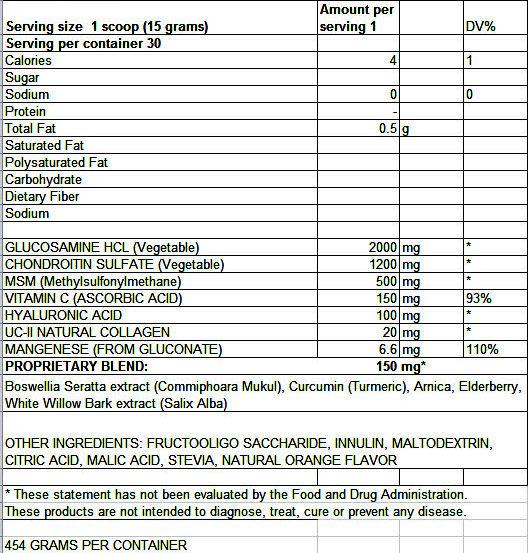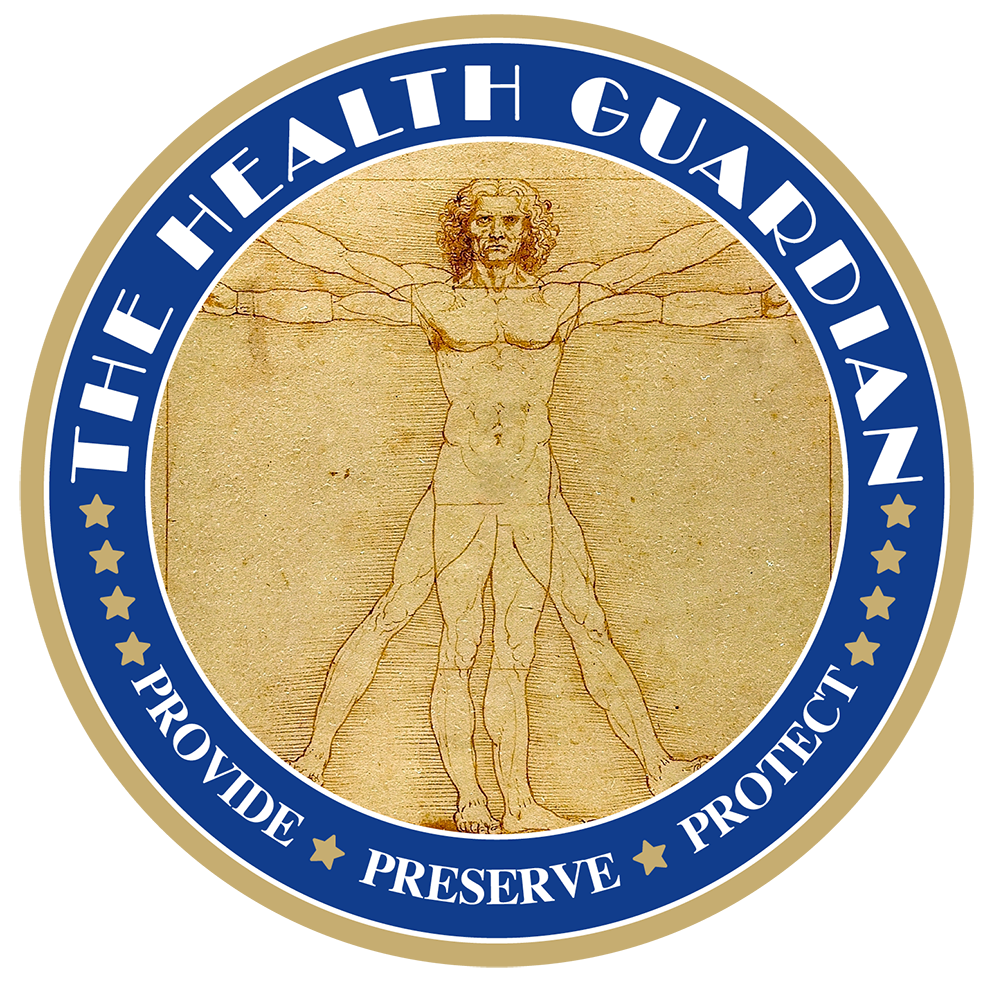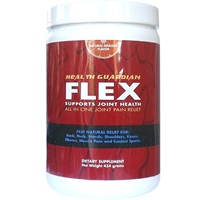Products:
Natural Pain Relief Supplement
Health Guardian Flex® contains 5 powerful nutrients to reduce joint pain and inflammation and 5 nutrients to help in restoring and preserving joint function.HG Flex® comes in a delicious natural orange flavored powder. It is sweetened with Stevia and is only 4 calories per serving. HG Flex® dissolves easily in water and can be absorbed quickly to begin fighting joint pain.
*Individual results may very
Product Reports
Joints form the connections between bones. They provide support and help you move. Any damage to the joints from disease or injury can interfere with your movement and cause a lot of pain.
Many different conditions can lead to painful joints, including osteoarthritis, rheumatoid arthritis, bursitis, gout, strains, sprains, and other injuries. Joint pain is extremely common. In one national survey, about one-third of adults reported having joint pain within the past 30 days. Knee pain was the most common complaint, followed by shoulder and hip pain, but joint pain can affect any part of your body, from your ankles to your shoulders. As you get older, painful joints become increasingly more common. Joint pain can range from mildly irritating to debilitating. It may go away after a few weeks (acute), or last for several weeks or months (chronic). Even short-term pain and swelling in the joints can affect your quality of life. Whatever the cause of joint pain, you can usually manage it with medication, physical therapy, or alternative treatments. Your doctor will first try to diagnose and treat the condition that is causing your joint pain. The goal is to reduce pain and inflammation, and preserve joint function.
Arthritis and Joint Challenges
According to the Arthritis Foundation almost 50 million Americans have some kind of arthritis. Arthritis can limit such every day activities such as walking, dressing, and bathing. Simple things! There are many people who do not have arthritis who suffer with pain and joint stiffness associated with normal wear and tear and stress on the joints of the body.
The Baby Boomers who are entering their 50s and 60s are concerned about this issue. Even younger consumers are taking bone and joint health very seriously. Among the general population, 71% are concerned about preventing arthritis or joint disease. After the age of 35, arthritis and joint challenges is one of the top six conditions of high concern.
Medications
For moderate-to-severe joint pain with swelling, an over-the-counter or prescription non-steroidal anti-inflammatory drug (NSAID) such as aspirin, ibuprofen (Advil, Motrin), or naproxen sodium (Aleve), can provide relief. A newer generation of NSAIDs known as Cox-2 inhibitors is also good for pain relief, but all except one of these drugs (Celebrex) have been removed from the market because of an increased risk of heart attack, stroke, and other cardiovascular events. You might remember that over 100,000 people died from taking Vioxx and Celebrex is the same type Cox-2 inhibitor and has everyone scratching their heads as to why the FDA still allows it to be sold. Just watch a 60 second Celebrex commercial on TV and the last 45 seconds of the commercial is taken up with all the warnings…yikes! NSAIDs also can have side effects, potentially increasing your risk for gastrointestinal bleeding. Did you know that 16,000 people die each year from just taking aspirin?
If you have milder pain without any swelling, acetaminophen (Tylenol) can be effective. Be careful when taking this medicine though, especially if you drink alcohol, because high doses may cause liver damage. Because of the risks, you should take any of these pain medications with caution.
If your pain is more severe that NSAIDs and Cox-2 medicines aren't effective enough, your doctor may prescribe a stronger opioid medication like OxyContin™ or Vicodin™. These are the most popular but there are over 100 versions of prescription opiate analgesics on the market containing hydrocodone. Because opioid drugs can cause drowsiness, you should only use them under a doctor's care. They also can cause constipation, which you can relieve by taking laxatives, but most important is they are very addictive. It is estimated that currently approximately 31 million people are addicted to pain killers in the United States.
The Problem with Prescription Pain Killers
The underlying problem with prescription pain killers other than the above mentioned side effects is they do not treat the real problem causing the pain. There are over 100 forms of arthritis. The main two forms of arthritis are osteoarthritis and rheumatoid arthritis. Osteoarthritis is caused from cartilage losing its elasticity. If the cartilage is stiff it becomes damaged more easily. The cartilage, which acts as a shock absorber, will gradually wear away in some areas. As the cartilage becomes damaged tendons and ligaments become stretched, causing pain. Eventually the bones may rub against each other causing very severe pain. Though the pain killers can relieve the pain they cannot repair the loss of cartilage protecting the bone on bone and a person needs to continue to increase the dosage of the pain killer which increases its risks of addiction and other terrible side effects.
The other most common form of arthritis is rheumatoid arthritis (RA) which is a chronic autoimmune disease that causes inflammation and deformity of the joints. In an autoimmune disease like RA, this immune cycle spins out of control. The body produces misdirected immune cells, which accidentally identify parts of the person's body as foreign. These immune cells then produce a variety of chemicals that injure and destroy parts of the body. RA can begin very gradually, or it can strike quickly. The first symptoms are pain, swelling, and stiffness in the joints. The most commonly involved joints include hands, feet, wrists, elbows, and ankles, although other joints may also be involved. The joints are affected in a symmetrical fashion. This means that if the right wrist is involved, the left wrist is also involved. Patients frequently experience painful joint stiffness when they first get up in the morning, lasting for perhaps an hour. Over time, the joints become deformed. The joints may be difficult to straighten, and affected fingers and toes may be permanently bent (flexed). The hands and feet may curve outward in an abnormal way. In rheumatoid arthritis (RA), the synovial membrane is attacked and becomes severely inflamed. Usually thin and delicate, the synovial membrane becomes thick and stiff, with numerous infoldings on its surface. The membrane is invaded by white blood cells, which produce a variety of destructive chemicals. The cartilage along the articular surfaces of the bones may be attacked and destroyed, and the bone, articular capsule, and ligaments may begin to wear away (erode). These processes severely interfere with movement in the joint. RA exists all over the world and affects men and women of all races. In the United States alone, about two million people suffer from the disease. Women are three times more likely than men to have RA. About 80% of people with RA are diagnosed between the ages of 35-50. RA appears to run in families, although certain factors in the environment may also influence the development of the disease. Once again pain killers may help with covering up the pain but do little to reverse this chronic condition or repair the synovial membrane.
HG Flex®
Research indicates that arthritis and joint challenges are the number one condition that consumers indicate they would treat (68%) or prevent (69%) with natural supplements. Let me breakdown for you why I believe HG Flex® is one of the best natural products for treating these painful joint conditions. First of all HG Flex® contains a wide range of natural anti-inflammatories which do not cause addiction or the other side effects like gastrointestinal bleeding or even death. Secondly, HG Flex® actually contains proven natural ingredients that help restore the worn out cartilage as well as replace the missing synovial fluid that will help produce a smooth joint function. Let me break it down further and show you the powerful ingredients in HG Flex® and how each one will benefit you and have you dancing like you were a teenager.
Rebuild…Restore…Rejuvenate
- Glucosamine HCL (Vegetable Source) 2000 mg: Glucosamine in the body is used to make a “cushion” that surrounds the joints. In osteoarthritis, this cushion becomes thinner and stiff. Taking glucosamine hydrochloride as a supplement helps to supply the materials needed to rebuild the cushion.
- Chondroitin Sulfate (Vegetable Source) 1200 mg: Chondroitin is a component of human connective tissue found in cartilage and bone. Chondroitin reduces pain and swelling, improves joint function and slows the progression of osteoarthritis.
- MSM 500 mg: Methylsulfonylmethane is an organic source of sulfur which provides the sulfur our bodies need to create vitamins, amino acids, connective tissues, antioxidants and collagen. Sulfur is the eighth most abundant element in all living organisms. In the human body it forms part of virtually all tissues, especially those highest in protein, such as blood cells, muscles, skin and hair. MSM relives pain, inflammation and stiffness both from bone and muscle disorders like arthritis and from over-exertion, stress or injury. In a study of osteoarthritis, the most common of all joint diseases, MSM provided pain relief equal to Motrin without toxicity.
- Vitamin C (Ascorbic Acid) 150 mg): It’s one of the most familiar of all nutrients, but vitamin C’s role in joint health tends to be underappreciated. Vitamin C not only helps produce collagen, a major component of joints, but sweeps the body of destructive molecular byproducts known as free radicals, which are destructive to joints and cause inflammation.
- Hyaluronic Acid 100 mg: Hyaluronic acid is found in all connective tissue, joints, body cavities, joint spaces, and tissue surfaces. The highest levels are found in the synovial fluid of all joints and the skin. There are also high levels of hyaluronic acid found in the eyes, cartilage, heart, intervertebral discs of the spine and in the fluids of the inner and middle ear. The level of hyaluronic acid in the human body declines with age, causing problems with the structural integrity of the body. Hyaluronic acid is important in the lubrication of joints, integrity of tissues, fighting bacterial invasiveness, elasticity of skin, vision, and molecular transport between cells. Hyaluronic acid fills the intercellular space between collagen and other cells, providing support and the essential framework for tissues. In the joint, hyaluronic acid also acts as a shock absorber and structural stabilizer.
- UC-II® Natural Collagen 20 mg: Undenatured Type II Collagen is the principal structural protein in cartilage that is responsible for its tensile strength and toughness. Derived from chicken sternum cartilage, UC-II® consists of Undenatured (native) Type II Collagen that works with the immune system to support healthy joints and promote joint mobility and flexibility.
- Manganese Gluconate 6.6 mg: Manganese is a nutritionally essential mineral element. Manganese gluconate helps to support many essential functions in your body and has been used to improve bone health and treat symptoms of osteoporosis and osteoarthritis. Manganese gluconate also aids in the formation of connective tissue, such as collagen, ligaments, tendons, and fascia.
Reduce Pain (150 mg Proprietary Blend)
- Boswellia Seratta: Boswellia seratta is also known as frankincense. Extracts of Boswellia serrata have been clinically studied for osteoarthritis and joint function, particularly for osteoarthritis of the knee. Positive effects of Boswellia in some chronic inflammatory diseases including rheumatoid arthritis, bronchial asthma, osteoarthritis, ulcerative colitis and Crohn's disease have been reported due to its potent analgesic, anti-arthritic, anti-proliferative and anti-inflammatory effects that can reduce the pain and inflammation of joints.
- Curcumin: Turmeric is a powerful spice used widely in India both for its taste-enhancing aspects and its ability to heal. This connection between turmeric and arthritis exists thanks to one active compound in turmeric known as curcumin. This compound possesses anti-inflammatory and anti-arthritic properties, allowing it to be used as an effective natural arthritis treatment. Curcumin’s ability to inhibit several enzymes involved in the onset of inflammation, including cyclooxygenase-2, or COX-2, makes turmeric rank #1 among any natural arthritis treatment. Since curcumin can suppress the enzyme COX-2, the production of prostaglandins – compounds that trigger inflammation and cause swelling and pain - is reduced. This makes curcumin a natural COX-2 inhibitor and because it has no known side effects it is a much safer choice than Celebrex which is a drug similar to the problematic Vioxx™.
- Arnica: Arnica is a plant found in the mountainous areas of the United States and is great for bruises, sprains, soreness, swelling, and for the relief of arthritis, joint pain and muscle pain.
- Elderberry: Elderberry, also called elder flower, is native to Europe, but have been naturalized to the Americas, and have a long history of medicinal use, particularly in England, where it is commonly used to make elderberry wine and pies, and was once referred to as "nature's medicine chest." Elderberry has compounds called anthocyanins, which have an anti-inflammatory effect, thus reducing aches and pains.
- White Willow Bark: White willow has been used to combat fevers and pain for thousands of years. Willow bark may be the oldest herb known to treat pain and inflammation…the oldest recorded use is by Chinese physicians in 500 B.C. The inner bark of the white willow tree contains salicin, which is changed to salicylic acid in the body. The compound in aspirin, acetylsalicylic acid, is derived from salicylic acid. Herbalists use white willow much the same as aspirin to reduce fevers, pain, and inflammation in conditions such as arthritis. White willow works slower but lasts longer than aspirin and has no gastronomic side effects due to the large amounts of tannins that protect the stomach. IN CONCLUSION HG Flex® comes in a delicious natural orange flavored powder. It is sweetened with Stevia and is only 4 calories per serving. Once the powder is mixed with water it becomes a liquid which is 98% absorbable. One can expect an immediate reduction in pain but the restoration of the cartilage and synovial fluid will take time…so be patient. The condition causing your joint pain and stiffness did not happen overnight, so don’t expect it to be resolved overnight. Recommended dosage is one scoop with 4 to 8 ounces of water for normal maintenance and prevention. You can take 1 to 2 scoops twice per day if experiencing minor to major discomfort.
About the Author:
Harry Elwardt is a naturopathic doctor with a PhD in Health & Nutrition. He is also the author of the book, “Let’s STOP the #1 Killer of Americans TODAY!” Dr. Elwardt has declared war on heart disease and travels the country lecturing on what Americans can do to prevent and reverse this merciless killer. If you would like to schedule Dr. Elwardt to lecture and conduct heart screenings in your church or business establishment, email him at drharry@comcast.net
Supplement Facts



